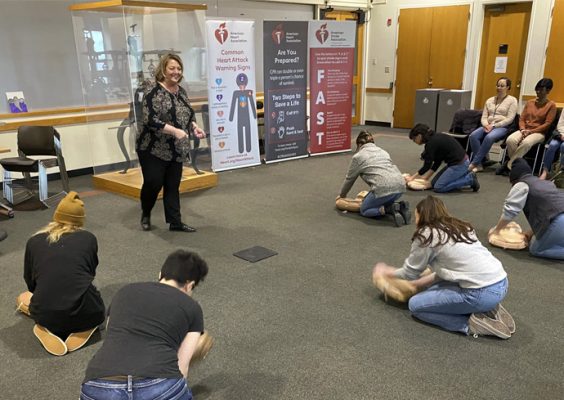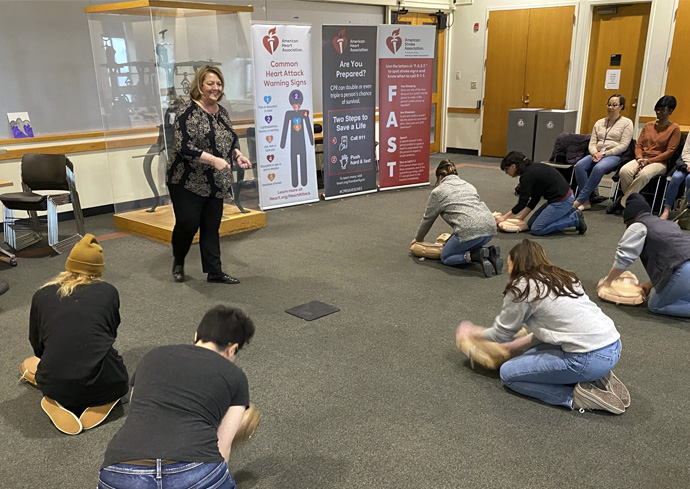Seconds Can Save a Life: CPR and AED Trainings Prepare Bystanders to Act in an Emergency
February is American Heart Month, a time that promotes renewed focus on cardiovascular health and increased education on the risk factors for heart disease, currently the leading cause of death in the U.S.
It’s not only in February, however, that Syracuse University’s Wellness Initiative, housed in the Office of Human Resources, partners with the American Heart Association (AHA) to offer potentially life-saving training opportunities to the University community.

Since October, hourlong, non-certifying trainings have been offered monthly to faculty and staff, providing instruction for performing cardiopulmonary resuscitation (CPR) and using an automated external defibrillator (AED).
AHA facilitators train participants on:
- how to recognize the signs of cardiac arrest or a stroke;
- responding with hands-only CPR, which entails using chest compressions but not rescue breaths; and
- the importance of AED usage.
Two upcoming opportunities will be held on March 21 in 500 Hall of Languages. More than 350 faculty and staff members have been through the training, with dozens more participating this spring.
Earlier this year, Buffalo Bills safety Damar Hamlin suffered cardiac arrest during a “Monday Night Football” game. His life was saved by the quick administration of CPR and use of an AED to restore his heartbeat on the field, sparking a surge in interest in participating in these trainings nationwide.
Candace Campbell Jackson, senior vice president and chief of staff to Chancellor Kent Syverud, has been instrumental in bringing these training opportunities to campus, and has requested that all members of the University leadership team take part and encourage their faculty and staff to do the same.
“I’m proud of the way our university leadership and community have enthusiastically embraced the opportunity to learn these life-saving techniques,” says Campbell Jackson. “By bringing heart health education to our faculty and staff, we all stand better prepared to save a life at work or at home.”
Jackson also serves as 2023 chair of the Syracuse Go Red for Women campaign, part of a national movement to promote education and action among a population increasingly impacted by cardiovascular disease: women. According to the Centers for Disease Control and Prevention, heart disease was responsible for about 1 in 5 women deaths in 2020.
“Learning CPR will help save lives,” says Franklin Fry, executive director of the Greater Syracuse AHA. “Each year, there are more than 350,000 out-of-hospital cardiac arrests in the U.S. Unfortunately, only about 10% of those patients survive. However, immediate CPR and AED use can double or even triple a victim’s chance of survival. Each person taking part in these trainings has the potential to be a lifesaver.”
Adam Hepburn, executive director of operations in the Office of Strategic Initiatives and Innovation, participated in the training last fall. He found it so effective he went on to encourage colleagues from the National Veterans Resource Center at the Daniel and Gayle D’Aniello Building (NVRC) to participate.
“We have an active building, with lots of students, faculty, staff and community members coming through, including for special and large events,” Hepburn says. “There’s a recognition that we all want to be prepared should an incident occur.”
The Rev. Brian Konkol, dean of Hendricks Chapel, similarly encouraged his team to take advantage of the on-campus trainings to be better prepared in a worst-case scenario.
“The training instructors were insightful and the overall experience was impactful,” he says, reflecting on the experience. “I am thankful that Syracuse University chose to make CPR/AED trainings a top priority, as all people are of infinite dignity, and being better prepared may help to save lives.”
To learn more or sign up for an upcoming training, visit the Wellness Initiative website.


